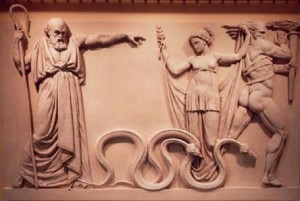Why do we celebrate St. Patrick’s Day at a pub or restaurant instead of at home, when Irish food is so easy to prepare?
For the party, don’t you think? To see friends, hear music, dance, have another beer and laugh and stay up later than maybe we should on a work night.

The "snakes" St. Patrick is said to have driven out of Ireland were not snakes at all. The snake was--and remains--a symbol for Paganism.
The food is part of the ritual but it’s not really the main point. If, for you, it is the main point you won’t do better than cooking at home. The traditional dish, corned beef and cabbage with potatoes and carrots is almost ridiculously easy to prepare successfully. But it’s not your only option. Yesterday’s post, which you can find here, includes links to ten recipes from the Seasonal Pantry archives. In this post, you’ll find five of my favorite recipes, also from the archives but before they were posted on line. Add a butter lettuce salad with mustard vinaigrette and you’ve got a feast fit for a saint.
St. Patrick did not drive the snakes out of Ireland. There are no snakes in Ireland; it’s a function of geography and climate, not cosmology. He drove out Ireland’s pagan heritage--the snake is a common symbol in Paganism–and given this, celebrating at home is probably the truest way to honor the holiday. I suspect St. Patrick would be appalled at the bacchanal his day has become in the US.
Corned Beef and Cabbage
Serves 8
This is the version of corned beef and cabbage that I’ve been cooking for a couple of decades. It’s almost impossible to mess up; just be sure to cook the corned beef long enough, so that it is very tender.
- 1 raw brisket of corned beef, about 4 pounds
- 2 teaspoons black peppercorns
- 3 whole small dried chiles or 1 teaspoon red pepper flakes
- 1 bay leaf
- 2 thyme sprigs
- 3 Italian parsley sprigs
- 6 large yellow onions, peeled and cut into sixths
- 3 medium carrots, peeled and cut into diagonal 2 1/2-inch pieces
- 6 medium potatoes, scrubbed and cut into wedges
- 5 pounds cabbage, cored and cut into 3-inch wedges
- 1/2 cup heavy cream
- 3 tablespoons prepared horseradish
- 3 tablespoons minced fresh Italian parsley
- Rinse the corned beef under cool tap water. Set it in a large pot, add the peppercorns, chiles, bay leaf, thyme sprigs, parsley sprigs, half the onions and enough water to come about 4 inches above the brisket. Bring to a full boil over high heat, reduce the heat to medium low and use a large shallow spoon to skim off the foam and other impurities that rise to the surface.
- Cover the pot, setting the lid slightly off center so that it is not a tight fit. Simmer 2 hours. Remove the lid and using a slotted spoon, remove and discard the onions and herb sprigs. Add the remaining onions and carrots and simmer, partially covered, for 30 minutes. Add the potatoes and simmer until they are almost tender, about 20 minutes. Add the cabbage, pressing it down into the liquid (it will rise back up but don’t worry about it). Cover the pot and simmer 20 minutes, or until the cabbage is tender but not mushy.
- Meanwhile, put the cream into a small bowl and stir in the horseradish and 1 tablespoon of the minced parsley. Taste, season with salt and pepper and set aside.
- Use a large fork or tongs to transfer the brisket to a serving platter; cover it loosely with aluminum foil and let rest 15 minutes. Slice the corned beef and return it to the platter. Use a slotted spoon to transfer the vegetables from the pot to the platter; sprinkle the parsley over the vegetables. Serve immediately, with the horseradish cream on the side.
Irish Stew
Serves 8
There are so many versions of Irish stew. These days, most include carrots, beef stock and a lot of spices, none of which are traditional. Even the potatoes are a contemporary conceit that are not found in the most traditional versions. If you prefer, leave the potatoes out of the stew and serve it with Potato Souffle.
- 4 large onions, peeled and cut into 1/4-inch slices
- Kosher salt
- Black pepper in a mill
- 4 pounds lamb shoulder, cut into 1 1/2-inch pieces
- 36 very small new potatoes, washed and halved
- 4 thyme sprigs
- Arrange half the onions on the bottom of a clay pot or other deep ovenproof pot. Season with salt and pepper, add the lamb, season it with salt and pepper and top with half the potatoes. Set the thyme sprigs on top of the potatoes and repeat with the remaining ingredients.
- Add 2 cups of water, season a final time with salt and pepper and cover the pot with its lid. Set in a cold oven, turn the heat to 300 degrees and bake for 3 hours.
- Remove from the oven and let rest at least 15 minutes before serving.
Variations:
- Use 1 cup water instead of 2 and add 1 cup Guinness, 1 cup white wine, or 1 cup red wine.
- Replace half the potatoes with very small turnips.
Potato Souffle
Serves 6 to 8
Serve this yummy souffle with any meat dish, especially stews and roasts. It is not quite as fragile as many souffles, so if you’ve been nervous about making one, this is a good place to start.
- 6 medium russet potatoes, scrubbed and baked until tender
- 1 stick (4 ounces) butter, at room temperature
- 1/2 cup whole milk or half-and-half, hot
- Kosher salt
- Black pepper in a mill
- 3 egg yolks, beaten until pale
- 4 egg whites, beaten to stiff peaks
- While the potatoes are still fairly hot, break them in half and press them, broken side down, through a potato ricer into a medium mixing bowl. (If you do not have a potato ricer, peel the potatoes and pass them through a food mill.)
- Preheat the oven to 425 degrees. Use a small amount of the butter to grease the inside of a souffle dish. Season generously with salt and pepper and beat in all of the remaining butter and the hot milk.
- Add the egg yolks and mix thoroughly. Use a rubber spatula to gently fold in the egg whites; do not overmix. Scrape the mixture into the souffle dish, set the dish in the middle of the bottom rack and bake until the top is lightly browned, about 25 minutes. Remove from the oven and serve immediately.
Variations:
- Add 3 tablespoons fresh Italian parsley minced as finely as possible to the cream.
- Replace 2 tablespoons of the butter with 2 tablespoons bacon fat and fold in 1/4 cup crumbled bacon with the egg yolks.
Irish Coffee Jelly
Serves 4 to 6
I ran across this recipe in a sweet little book, Irish Countryhouse Cooking, written by Rosie Tinne in 1974. The book is a collection of recipes from home cooks throughout Ireland and gives an interesting glimpse into how people fed each other at the time. Unfortunately, not a single recipe has an introduction so we learn nothing about the person who provided it or the context in which it was served. But obviously, this boldly flavored jelly is a dessert, and a fine one, I might add.
- 1 1/2 cups very strong coffee
- 2 tablespoons superfine sugar
- 2 envelopes (1/2 ounce) powdered gelatin
- 1 1/2 cups Irish whiskey
- 1/2 cup heavy cream
- Put the coffee into a small saucepan, add the sugar and set over medium heat. Stir until the sugar is dissolved and the coffee just begins to simmer. Remove from the heat, add the gelatin and stir until it is completely dissolved. Let cool a bit longer and stir in the whiskey.
- Divide the liquid jelly into small serving glasses or cups and chill until completely set, about 2 hours (more or less depending on the size of the container).
- To serve, use a whisk to whip the cream. Add a dollop to each portion and serve immediately.
Corned Beef Hash
Serves 6
If you can resist the temptation to use leftover corned beef to make sandwiches, you can make a wonderful corned beef hash. This dish is one of the best breakfasts in the world but it also makes a great dinner, especially on a cold or stormy night.
- 2 dozen very small new red potatoes or creamer potatoes, washed thoroughly
- Kosher salt
- 2 tablespoons olive oil
- 1 medium onion, diced
- 6 cups (about 2 pounds) cooked corned beef, cut into 3/4-inch cubes
- 2 tablespoons minced Italian parsley
- Black pepper in a mill
- 6 eggs, optional
- Tabasco sauce, optional
- Put the washed potatoes into a heavy saucepan, cover them with water, add a tablespoon of kosher salt and bring to a boil over high heat. Reduce the heat to medium and cook until the potatoes are tender when pierced with a fork or bamboo skewer. Drain, saving a cup or so of the cooking water, and let cool to room temperature.
- Meanwhile, pour the olive oil into a heavy skillet set over medium heat, add the onions and cook until they begin to soften, about 5 to 6 minutes. Reduce the heat to low, add the corned beef and cook, tossing now and then, until the meat is heated through, about 7 or 8 minutes.
- Use a fork to crush each potato. Add the potatoes to the meat mixture, along with half a cup of the cooking liquid. Do not stir. Cover and cook 5 minutes.
- Transfer to a warm bowl and toss gently with a fork. Cover and keep warm.
- To serve immediately, divide among individual plates and sprinkle with parsley. To serve with eggs, divide the hash among individual plates or soup plates and set in a warm (200 degree) oven. Poach the eggs, one or two at a time, in gently simmering water until the whites are just set, about 2 to 3 minutes. Set one poached egg on top of each portion of hash, sprinkle with parsley and salt and serve immediately, with Tabasco sauce alongside.


